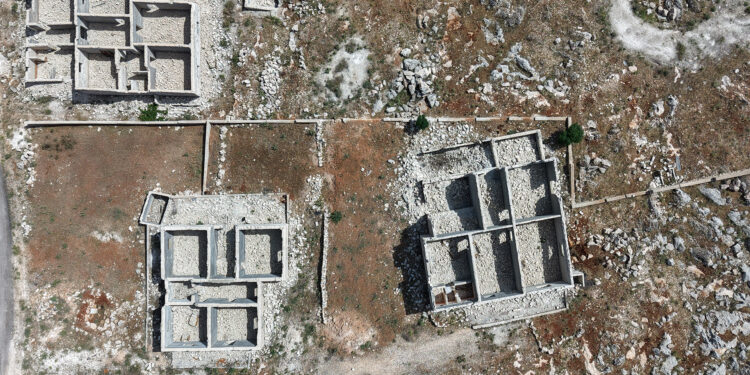Muhammad al -Bro returned to his home in the Kafr Barmeh area, south of Idlib, after 6 years of displacement and living in tents, as a result of the 2019 attack launched by the ousted Syrian regime, to be surprised by a shocking scene where he destroyed the ceiling of his house and was fully stolen.
The Pro, whose house was built in 2017 at a cost of about 40 thousand dollars, confirms that its restoration today will cost him more than 80,000 due to the double prices of all basic materials from workers ’wages to iron, cement and fuel, in addition to the costs of transporting water and goods.
“For a while I did not have a fixed work, and all I had earned, spent on living without the ability to save. After returning, I do not even have what covers the ceiling of the house with nylon.”
“I thought about selling my agricultural ground to finance the restoration of the house, but after the trees were uprooted by the regime’s army, the brokers became only a quarter of their value. Therefore, I returned to the tent and decided to stay there until organizations once sponsored the restoration of our homes.”
Crazy
Thousands of displaced people decided to return to their homes for their restoration after liberating their areas, after 6 years of displacement from the eastern and southern Idlib countryside, the northern Hama countryside, and the western countryside of Aleppo, which is one of the most affected areas by the bombing and sabotage that the regime has implemented. But they were surprised by the high prices of building materials and workers’ wages.
The price of a ton of iron rose from 610 to $ 670, while the price of a ton of cement increased from 103 to 123 dollars. Prices continue to rise with the increase in demand.
Workers’ wages also multiplied from $ 4 per day to between 15 and 20 dollars, while some workshops require record numbers, due to the scarcity of workers and many of them went to work in government jobs.
The price of a “Hurdey” component poured from $ 15 to 30 dollars increased, and the price of pouring the “Balata” bitten increased from 10 to 20 dollars. These numbers indicate a double cost compared to what they were before the liberation of the regions.
Many attribute this rise to the recent amendments to the customs tariffs imposed on cement and iron imported from Türkiye across the crossings between the two countries, which greatly affected the movement of the markets in the north of Syria.
Almost absent services
Hazem Al -Hadi (owner of a building material in Kafr Nabl south Idlib) confirms that the commercial activity in the construction sector is still weak compared to the population, as the percentage of returnees ranges between 5% and 10%. Even who returned, most of them are men who came to work due to the high cost of living.
He says, “All the residents of these villages are displaced who do not have the livelihood of their day, the majority of their homes are destroyed, and any ceiling, no matter how simple, needs about two thousand US dollars, which is a large amount for any delegate outside his town, especially since the past years have been full of unemployment and low wages.”
The absence of basic services – from electricity, schools and medical points – has led thousands to hesitate to return to their homes, so their maximum ambition has entered humanitarian organizations to restore their homes, even partially, due to their inability to cover a small part of the high costs.
Shocking numbers
Abdel -Bari Shehoud, an engineer and official in the Municipal Council, confirms that the percentage of destruction in areas on the seam lines is completely 50% destroying, and about 40% partial destruction, pointing out that most of the houses were damaged except for those that the regime’s army used as military barracks.
“We met with the governor and demanded that support to the basic services, and we prepared to work to return them, especially the medical points and the deportation of ruins and schools before the beginning of the school year, in addition to the restoration of the electricity, which may facilitate the return of a number of residents of the camps.”
Because of the deterioration of the situation, many of the displaced were forced to carry their tents or alternative homes made of insulating plastic, and to return to their destroyed villages, despite the absence of vital services, especially medical care.
A city without life
Mahmoud Al -Ahmad, who returned with his wife and son to Maarat al -Numan, a region whose population in the city and the countryside is more than half a million people, describing the situation at night as “brutal” where there is no traffic, no lights, nor residents.
“Only 50 families have returned to our village out of 3,200 families, which are a very small percentage. There are no neighbors near us, which makes it very difficult if I am absent from home to work,” he added.
He tells a tragic story about a forty -year -old young man who suffered a heart attack while working on agricultural land, so his brother tried to help him with his fiery bomb, but after an hour of reaching the nearest medical point, the young man had died as a result of the delay.
It is noteworthy that these areas were subjected to a systematic uprooting of tens of thousands of fruitful trees, especially olives, figs and pomegranate, which constituted a severe blow to the agricultural sector in the southern Idlib countryside, which depends on salivary agriculture as an essential source of income and food, which increased the complexity of the conditions of return for many of the displaced.



